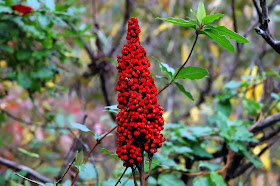There were caterpillars still out a couple weeks ago. As I stepped out of my office to look for a few, a student stopped me and asked if this was a lizard. He had never seen one in Ohio. Sure enough, it was a young fence lizard or Fence Swift. Temperatures had already begun to drop, so this guy spent all his time sunning openly on the heated rocks.
One of the caterpillars I found was Spilosoma virginica. This species is rusty orange colored, often with interspersed black hairs. It is better known as the Virginia Tiger Moth. The adult is one of the several "all white" tiger moths.
Later that night, my Entomology class was excited about setting up a light and sheet to attract insects. Well it figures, the night was cold, and very few insects came in. Sitting on an oak nearby was this sphinx moth larva. It is one of the 'eyed' sphingids. Their caterpillars all look similar. This one is the Blind-eyed Sphinx, Paonias excaecata.
Cream colored stripes reach down to the spiracles, with the last stripe at the horn being most predominant. The red spots near the prolegs vary in size and intensity. The head contains a green and white stripe, while the body is covered in white granules.
Fall brings a profusion of fruit, some of which is edible. One of my favorites is Blackhaw Viburnum, Viburnum prunifolium. It's not sweet and juicy, but more subtle. It has a thicker, mushier texture like that of raisins or prunes. Suck on the black ones, and spit out the seed. I think they are delicious.
When you hear people say "plant native", this is a good choice. Viburnums have showy flowers, and the fruits persist, making them a good winter bird food.
S.E. Ohio is known for its fall colors. Our Beech-Maple forests are currently turning, but our Oak woods are still green. Look on the forest edges for the best color right now, especially on the smaller species.
One of those is the Flowering Dogwood, Cornus florida. Those red football fruits are not edible for us, but wildlife will grab them up.
American Hazelnut, Corylus americana, is turning orange-scarlet right now. Though a small shrub, they do add to the color variety.
Hazelnut is most easily identified by the caterpillar-like catkins hanging down.
Because the fruit grow in large heavy clusters, they usually have fallen to the ground by now. If you are lucky enough to still find them, they are edible. Hazel is used a lot to flavor coffee. It's the European Hazelnut, or what is known as a Filberts Nut that is sold in stores. Our native species will work just the same. Mammals are big consumers of these.
American Bittersweet, Celastrus scandens. While very showy, this one is poisonous to humans. Wildlife will seek it out. Bittersweet is not only a climbing vine, but a choker. It will kill young trees it grows on. Older trees with thicker bark are not as susceptible. The plant produces orange pumpkin like capsules that split open to reveal a bright red seed.
Another plant that has turned all red is the Winged Sumac, Rhus copallina. There are wing like growths between the leaflets, making this easy to identify. The second photo shows how glossy looking the leaves can get, leading to another common name, the Shining Sumac.
Perhaps the most brilliant looking plant right now is the Smooth Sumac, Rhus glabra. The rachis between the leaflets are smooth, containing no wings.
There are four red fruiting sumacs in Ohio, but Smooth Sumac is probably the best for making drinks. Collect the fruit heads and put them in a cheese cloth. Soak them in water, and you can make a pink lemonade.
A favorite among many is this peach-apricot flavored fruit known as Persimmon, Diospyros virginiana. Look in old fields for this species.
If you wish to indulge in eating these, make sure they are ripe!! If you see a wrinkled surface like this, and they are squeezable soft to the touch, they are ready. Hard unripe Persimmons will leave the most awful, dry, cotton mouth result on your tongue, and you'll wish you hadn't tried them!
Here's what happens after biting an unripe Persimmon!
Four legged animals love Persimmon, and it's an important quick energy source. This is fresh deer scat found under the trees. Technically it's known as Doodie!
Do you love that hickory smoked flavor? Well you get that from burning the wood, but the fruit is quite edible. If you like Walnuts, you'll probably like Hickory nuts. The thick husked fruits above can be found under Shagbark, Mockernut, and Kingnut. The thin husked fruits below are what's found on Pignut and Bitternut, Carya spp. People generally find the thick shelled species more desirable. Right now the squirrels are busy eating and hoarding them.
Another species in full fruit now is the Spicebush, Lindera benzoin. While I wouldn't eat the fruit right off the shrub, pioneers would dry the skins, chop it up like you would parsley, and use it as a spice substitute in the skillet.
When the leaves and fruit drop, Spicebush can be recognized by the BB or ball bearing buds. These buds, like the twigs, retain their aromatic oils year round. Crush them up and take a sniff. It may remind you a bit of Sassafras. They are in the same family, which also includes Camphor and Cinnamon.
Someone mention Sassafras? Sassafras my a** It's Halloween time, and that's a ghost if I ever saw one!



























Lovely photos and enjoyed the edible perspectives!
ReplyDelete